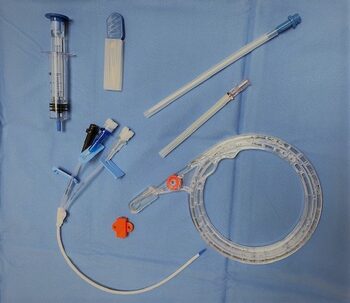- IT
- |
- EN

[Date of last update: Agosto 2021]
Bacteremia, defined as infections of the bloodstream (BSI - Blood Stream Infection), is a condition associated with high mortality and is a highly impacting event for healthcare organizations as it results in an unfavorable outcome in terms of healthcare quality.
In the United States, these conditions cause over 600 deaths every day and become a leading cause of mortality among patients treated [1].
It is estimated that between 15 and 30% of all hospital-acquired bacteremia are associated with intravascular devices [ 2], both central and peripheral, with an increased risk in intensive care units (ICU) and for services such as hematology, oncology and nephrology, as well as in university hospitals with over 500 beds [3].
Central line associated bloodstream infection (CLABSI) is a laboratory confirmed infection that develops at least 2 days after insertion of the central venous catheter [4]. It is a common complication associated with an increased cost of care, a prolonged hospital stay and increased mortality [5]. An estimated 250,000 cases of CLABSI occur in the United States each year, with a mortality rate of 10% [6]
Peripheral lines have complication rates of between 2.5% and 42%. Among these complications, up to 30% of cases include subcutaneous induration or phlebitis. [7]
According to various published studies, the organisms that most frequently cause infections related to intravascular devices are coagulase negative staphylococci and Staphylococcus aureus (2/3 of all infections), Gram-negative bacilli (20%) and yeasts [8].
[1]. Bloodstream Infection – Raquel M. Martinez, Donna M. Wolk – Microbiolspec August 2016 Vol. 4 no. 4 doi:10,1128/microbiolspec.DMIH2-0031-2016. https://journals.asm.org/doi/abs/10.1128/microbiolspec.DMIH2-0031-2016
[2]. Rodriguez Bano J., Lòpez PMD, Portillo MM, Retamar P, Natera C., Nuno E, et al. Epidemiology anc clinical features of community acquired, healtcare-associated and nosocomial bloodstream infection in tertiary care and community hospitals. Cin Microbiol Infect. 2010;16:1408-1413. doi: 10.1111/j.1469-0691.2010.03089. https://www.clinicalmicrobiologyandinfection.com/article/S1198-743X(14)60685-6/fulltext
[3]. Gallieni M, Pittiruti M, Biffi R. Vascular access in oncology patients. CA Cancer J Clin. 2008;58:323–346. doi: 10.3322/CA.2008.001Regione Emilia Romagna. MEMO_6. Antisepsi e disinfezione in ambito sanitario. Aprile 2011. https://acsjournals.onlinelibrary.wiley.com/doi/full/10.3322/CA.2008.0015
[4]. Galy A, Lepeule R, Goulenok T, Buzele R, de Lastours V, Fantin B. Presentation and impact of catheter-associated thrombosis in patients with infected long-term central venous catheters: a prospective bicentric observational study. Annals of medicine. 2016;48:182–189SIFO. Linee di indirizzo tecnico La disinfezione, gli adempimenti della vigente legislazione e i criteri di scelta di formulazioni ed apparecchiature che espletano attività disinfettante. Società Italiana di Farmacia Ospedaliera e dei Servizi Farmaceutici Territoriali. ISBN 978-8-86528-© 2015 by Edizioni Il Campano.
[5]. Glied S, Cohen B, Liu J, Neidell M, Larson E. Trends in mortality, length of stay, and hospital charges associated with health care–associated infections 2006-2012. Am J Infect Control. 2016;44:983–98Rapporto ISS COVID-19 · n. 19/2020 Rev Raccomandazioni ad interim sui disinfettanti nell’attuale emergenza COVID-19: presidi medico chirurgici e biocidi Gruppo di lavoro ISS Biocidi COVID-19. https://www.ncbi.nlm.nih.gov/pmc/articles/PMC5011005/
[6]. Brunelli SM, Turenne W, Sibbel S, Hunt A, Pfaffle A. Clinical and economic burden of bloodstream infections in critical care patients with central venous catheters. J Crit Care. 2016;35:69–74. https://pubmed.ncbi.nlm.nih.gov/27481738/
[7]. Webster J, Clarke S, Paterson D, Hutton A, van Dyk S, Gale C, et al. Routine care of peripheral intravenous catheters versus clinically indicated replacement; randomized controlled trial. BMJ. https://www.ncbi.nlm.nih.gov/pmc/articles/PMC2483870/
[8]. Almirante B, Limón E, Freixas N, Guidol F. VINCat program. Laboratory-based surveillance of hospital – acquired catheter-related bloodstream infections in Catalonia. Results of the VINCat program (2007-2010) Enferm Infecc Microbiol Clin. 2012;30:13–19. doi: 10.1016/S0213-005X(12)70091-5. https://www.sciencedirect.com/science/article/abs/pii/S0213005X12700915?via%3Dihub